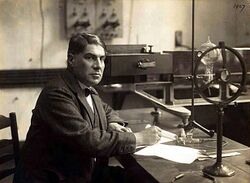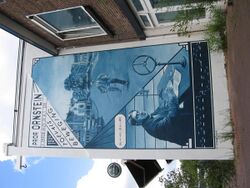Biography:Leonard Ornstein
Leonard Ornstein | |
|---|---|
 Leonard Salomon Ornstein (1927) | |
| Born | 12 November 1880 Nijmegen, Netherlands |
| Died | 20 May 1941 (aged 60) Utrecht, Netherlands |
| Alma mater | University of Leiden |
| Known for | Discontinuous electrophoresis Ornstein-Zernike equation Ornstein-Uhlenbeck process |
| Scientific career | |
| Fields | Physicist |
| Institutions | University of Utrecht |
| Doctoral advisor | Hendrik Lorentz |
| Doctoral students | 95 PhD students, for instance Marcel Minnaert H. C. Hamaker Hendrik Dorgelo Arie Andries Kruithof[1] |

Leonard Salomon Ornstein (12 November 1880 in Nijmegen, the Netherlands – 20 May 1941 in Utrecht, the Netherlands)[2] was a Dutch physicist.
Biography
Ornstein studied theoretical physics with Hendrik Antoon Lorentz at University of Leiden. He subsequently carried out Ph.D. research under the supervision of Lorentz, concerning an application of the statistical mechanics of Gibbs to molecular problems.[3]
In 1914, Ornstein was appointed professor of physics, as successor of Peter Debye, at University of Utrecht. Among his doctoral students was Jan Frederik Schouten. In 1922, he became director of Physical Laboratory (Fysisch Laboratorium) and extended his research interests to experimental subjects. His precision measurements concerning intensities of spectral lines brought Physical Laboratory in the international limelight.[4]:299–300
Ornstein is also remembered for the Ornstein-Zernike theory (named after himself and Frederik Zernike) concerning correlation functions,[5] and the Ornstein-Uhlenbeck process (named after Ornstein and George Uhlenbeck), a stochastic process.
Together with Gilles Holst,[6] director of Philips Research Laboratories (Philips Natuurkundig Laboratorium), he was the driving force behind establishing the Dutch Physical Society (Netherlands Physical Society, Nederlandse Natuurkundige Vereniging, NNV) in 1921. From 1939 until November 1940 he was Chairman of this Society. From 1918 until 1922 Ornstein was Chairman of the Dutch Zionist Society (Nederlandse Zionistische Vereniging). In 1929, he became member of the Royal Netherlands Academy of Arts and Sciences.[7]
Immediately after the involvement of the Netherlands in the World War II (see Battle of the Netherlands), a friend from the United States , the astronomer Peter van de Kamp, offered to bring Ornstein and his family to America. However, Ornstein did not accept this offer, since, as he put it, he would not leave his laboratory in Utrecht. Owing to his Jewish heritage, Ornstein was summarily dismissed from the University in September 1940. He was even barred from entering his own laboratory. In November 1940, he was officially dismissed from the University. On 29 November 1940 Ornstein willingly withdrew his membership of the Dutch Physical Society. During this period he increasingly distanced himself from public life, to the degree that he no longer wished to receive guests at home. Ornstein died on 20 May 1941, six months after being barred from University.[citation needed]
One of the five buildings of Department of Physics of University of Utrecht, the Ornstein Laboratorium, [8] is named in his honor.
Publications
- Toepassing der statistische mechanica van Gibbs op moleculair-theoretische vraagstukken, Phd Thesis 26 March 1908, in Dutch[3]
- Problemen der kinetische theorie van de stof, 1915
- Strahlungsgesetz und Intensität von Mehrfachlinien, 1924
- Intensität der Komponenten im Zeemaneffekt, 1924
- On the theory of the Brownian motion, 1930
- De beteekenis der natuurkunde voor cultuur en maatschappij, 1932[9]
See also
- Uithof
- Virial coefficient
References
- ↑ Arie Andries Kruithof, Mathematics Genealogy Project.
- ↑ This text is almost entirely based on the article by: de Lang, Herman (October 2006). "Geschiedenis: 'Vuile handen' in eigen boezem". Nederlands Tijdschrift voor Natuurkunde 72 (10): 334. http://home.hetnet.nl/~alchemilab/alchemie/DeLang2.htm. Retrieved 2007-03-30. [|permanent dead link|dead link}}] (in Dutch).
- ↑ 3.0 3.1 Ornstein, Leonard Salomon (1908-03-26). Toepassing der statistische mechanica van Gibbs op molekulair-theoretische vraagstukken. Leiden: Eduard IJdo. thesis. http://igitur-archive.library.uu.nl/phys/2006-0117-200056/UUindex.html.
- ↑ Pais, Abraham (1986). Inward Bound. Oxford: Oxford University Press. ISBN 978-0198519973. https://archive.org/details/inwardboundofmat00pais_0.
- ↑ Briels, W.J. (October 1998). "The Ornstein-Zernike equation and integral equations, in Theory of Polymer Dynamics". University of Twente, the Netherlands. http://cbp.tnw.utwente.nl/PolymeerDictaat/node15.html.
- ↑ Gilles Holst, by Albert van Helden, in K. van Berkel, A. van Helden and L. Palm, A History of Science in The Netherlands. Survey, Themes and Reference (Leiden: Brill, 1999), pp. 471-472. Digital Library of Royal Netherlands Academy of Arts and Sciences.
- ↑ "Leonard Salomon Ornstein (1880 - 1941)". Royal Netherlands Academy of Arts and Sciences. http://www.dwc.knaw.nl/biografie/pmknaw/?pagetype=authorDetail&aId=PE00002171. Retrieved 30 July 2015.
- ↑ "Leonard S. Ornstein Laboratory". Utrecht University. https://www.uu.nl/en/leonard-s-ornstein-laboratory.
- ↑ Speech in Dutch on the significance of physics to culture/civilisation and society: Ornstein, L.S. (1932). "De beteekenis der natuurkunde voor cultuur en maatschappij". pp. 22. https://dspace.library.uu.nl/bitstream/handle/1874/7518/1932-ornstein-beteekenis.pdf?sequence=1&isAllowed=y.
External links
- Snelders H.A.M. (2007-02-01). "Ornstein, Leonard Salomon (1880-1941)", in: Biografisch Woordenboek van Nederland. Retrieved on 2007-03-30. (in Dutch).
- The Ornstein-Zernike equation in the canonical ensemble
- Leonard Ornstein at the Mathematics Genealogy Project
 |

